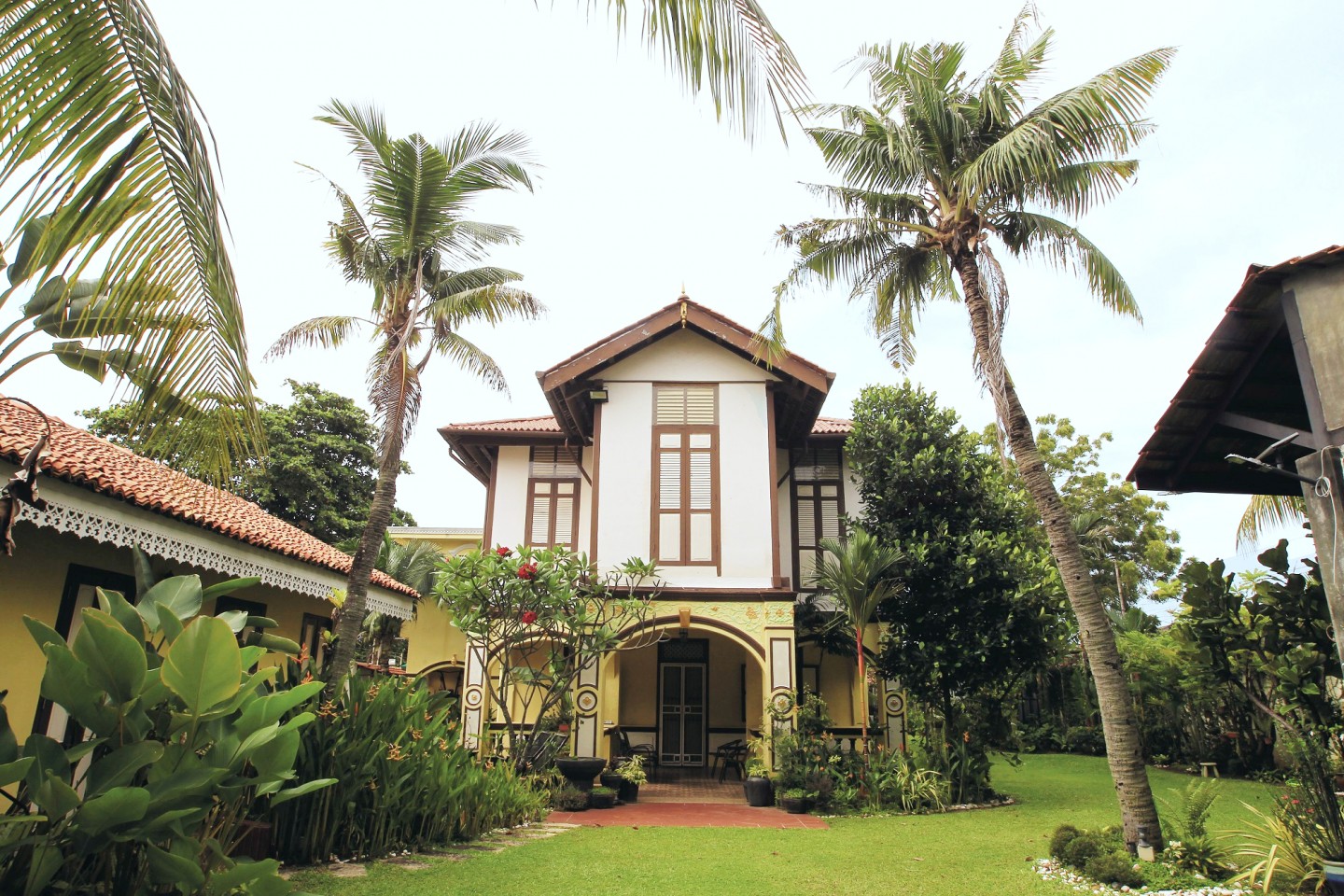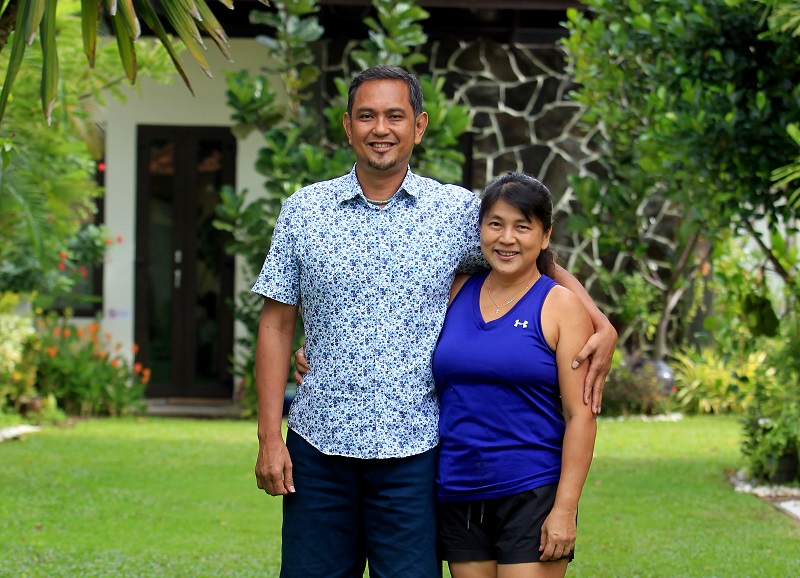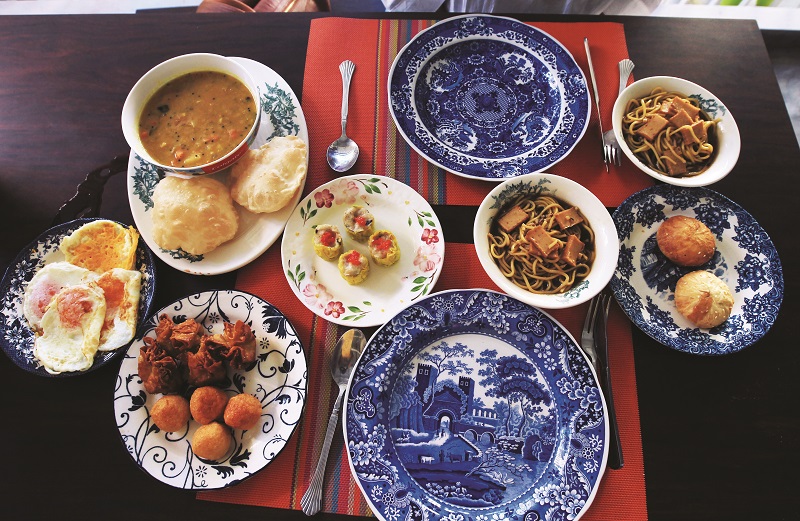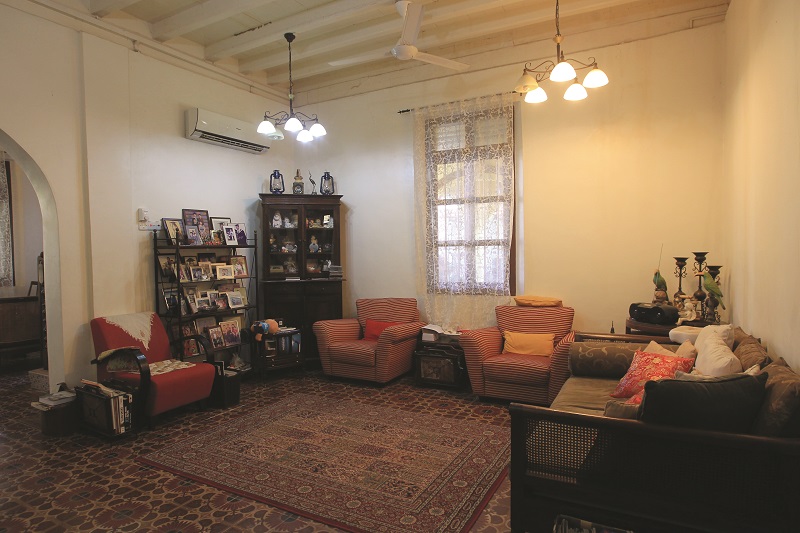
Casugria is made up of three Portuguese words pregnant with personal meaning — casa, susegadu and alegria (All photos: Mohd Izwan/The Edge Malaysia)
The name Adriaan Koek stared at Patrick Sean Santa Maria from the land title in his hands. A real estate investor, Patrick, 52, was suffused with a warm feeling as it dawned on him that the villa he had just bought once belonged to an eminent ancestor.
Uncannily, Patrick had put his money on the stately property without a clue about his blood ties with one of the last Dutch governors of Melaka. He was to learn later that the powerful Burgher had counted Munshi Abdullah — the father of modern Malay literature — and Sir Stamford Raffles, the founder of Singapore, among his friends.
Growing up in Melaka’s Portuguese settlement, Patrick had heard his father Gonzalo tell the Santa Maria boys on many occasions that they had some Dutch blood in them. Looking fondly at the black-and-white portrait of Delphina Zuzarte, Gonzalo, now 82, would tell Patrick and his three brothers that Delphina, their great-grandmother, was the daughter of Clementina Koek and their link to the country’s Dutch Eurasian community.
“To my ears, I don’t know why it sounded like the English name Cook,” says Patrick. He would not make the connection until half a lifetime later.
Patrick runs an inviting homestay at the Dutch villa that Adriaan built, sustaining a sentient connection with the centuries-old heritage that permeates the soil of Melaka. An affable storyteller, he has a steady stream of anecdotes about the charming cultural mélange that forms his childhood memories of the historical port city. Some stand out with a resonance that connects to values from a bygone era. Like the Portuguese word susegadu, which his grandmother would often use in conversation.
Patrick translates it as “contentment”, an attitude that equips one with balance in good times and bad. Susegadu — the word would pop up in his memory at various times in his life, during critical moments in the rough and tumble of his various business ventures in Kuala Lumpur.
20200818_peo_casugria_boutique_residence_35_msy.jpg

House of happiness and contentment
It left such a deep impression that Patrick made it the focal point of his homestay operation, called Casugria. The name is made up of three Portuguese words pregnant with personal meaning for him — casa, susegadu and alegria (house of happiness and contentment).
The boutique residence is nestled among a kaleidoscopic assortment of heritage sites in Bandar Hilir, at the heart of Melaka’s tryst with history. Two colourful Chinese temples, their ornate features drawing the eye, guard the homestay’s front and side along Jalan Parameswara’s narrow route in the city. Beyond it is the Infant Jesus Convent, with a restful field of green keeping the intruding new developments of the business quarter at bay.
The Casugria residence is sheltered by a high perimeter wall that hides its verdant grounds from passing view. A heavy side gate of sheet metal parts to reveal a cheerful garden lining the spacious property, where we are welcomed as Patrick’s guests.
At one side of the grand main entrance, now sealed, sits a stable that used to house the Koek family’s horse and carriage. Today, it serves as one of four chalets that visitors can rent to enjoy the ambience of those forgotten years.
Patrick welcomes us with a piquant drink tinged with lemongrass and hands us the keys to our cabin. Sporting a floral shirt and khaki shorts, he has a natural warmth that puts visitors at ease.
He takes care to show us how the soundproof doors work and leaves us to freshen up. We are to join him for tea a short while later.
Through the lace curtains that line the French windows of our comfortable room, the glassy water of the raised swimming pool beckons. Beyond it lies the double-storey villa, its rich yellow walls with brown and white accents exuding a venerable aura befitting its 210-year vintage. The colonial Dutch-style architecture, with its thick pillars, gentle arches and timber features, infuses the property with a restful presence.
pool.jpg

It is time to assemble for tea at the dining space behind the villa. We saunter over the lawn admiring the lush garden, thriving with palms and decorative plants of various species. Instead of a dining set, rattan sofas arranged around a coffee table evoke a casual feel in this common space.
Patrick and his wife Natasha join us and we soon discover that Casugria’s heart and soul are to be found in its homely dining area. Natasha, a botanist by training, is pleased that her vibrant plants are giving us much joy.
“I talk to them, you know,” she says, her love of nature showing in her look.
Patrick draws our attention to the array of snacks that has been laid out for us. “Try the epok-epok sayur,” he says, pointing to a heap of freshly fried vegetable puffs. “You’ll only find them in Melaka,” he declares, hinting at the state’s distinctive culinary diversity.
Elizabeth, Casugria’s cook, replenishes the trays sooner than we can sample her many offerings. True to her Indian descent, the vadais and curry puffs have a spicy edge to them. To neutralise that, we tuck into an assortment of Nyonya kuih, including staples such as kuih ketayap and kuih talam.
Personal voyage of discovery
The sharp, sweet aroma of frankincense wafts from the entrance of the dining space as Patrick plies us with tea and tales. Like his Iberian forefathers, he has a personal voyage of discovery that has shaped his life, through to his current enterprise.
“If you ask me what defines the identity of Portuguese Eurasians,” Patrick muses, “a big part of it, I would say, is the Catholic religion.” From feast days like the Festa San Pedro or Festa San Juan to the Intrudo that marks the beginning of Lent, to marriages and baptisms, all of the community’s events are steeped in Roman Catholic traditions. Moreover, it was almost an article of faith that Portuguese Eurasians in Melaka went to the St Francis Xavier Institution, a missionary school.
20200818_peo_casugria_boutique_residence_12_msy.jpg

For Patrick, however, a decision made by his father would take him off that beaten path. From very early on, Gonzalo wanted his son to thrive in a multicultural context. “My dad wanted me to interact with others. So, he sent me to the Bandar Hilir English school,” he says.
That led the young Patrick on a life journey that put him in contact with people from various backgrounds. He would spend three full decades among people of other races and religions doing business in Kuala Lumpur.
“Had I been xenophobic and too settled in my comfort zone, I wouldn’t have been able to succeed in business. That’s where I met my Hindu, Muslim and Chinese friends … and came to be all-embracing,” says Patrick gratefully.
A culinary melting pot
Although culturally distinct, the Portuguese Eurasians of Melaka have some traits in common with other communities in matters like food and dressing. “There’s a fine line between the Melaka Chitties, Portuguese Eurasians, Baba Nyonyas and Malays — all have been assimilated into the local landscape,” Patrick observes.
For instance, in all these communities, the ladies of an earlier generation wore the baju kebaya, he recalls. “And when I went to a Melaka Chitty house, I found pineapple prawn curry, a dish my grandmother used to make.”
Earlier, at lunch, we chanced upon the item at Nyonya Makko, a faithful custodian of Peranakan Chinese culinary secrets in Taman Melaka Raya, the new part of the city.
At dinnertime, we taste the range of cultural influences that have come together in the Portuguese Eurasian kitchen. They span the globe, reflecting Portugal’s outreach at the height of its imperial ambition in the 15th and 16th centuries.
The ample spread, hosted by Big Ben’s Restaurant, near the Portuguese settlement in Ujong Pasir, is a veritable gastronomic extravaganza. The trademark devil chicken curry and baked fish light up our taste buds with their rich mix of herbs and spices. But the versatile brinjal surprises us, dressed with a topping of ground pepper, chillies and other spices blended with the sweetness of coconut flesh.
“You’ll find similar dishes in Sri Lanka, Goa and even Brazil,” Patrick informs us. The owner is determined to drown us with hospitality and his speciality dishes, like a fleet of galleons, keep arriving at our table. Soon, we have to agree to a truce, promising ourselves to return another day to do justice to his culinary flair.
20200818_peo_casugria_boutique_residence_4_msy.jpg

Where 84 languages were once spoken
The conversation evokes images of the entrepôt’s heyday under the Melaka sultanate, rising around the year 1400 to spread its fame to far corners of the globe and ending in 1511 with its conquest by the fierce Portuguese admiral Alfonso de Albuquerque. To appreciate more of Melaka’s lost glory, Options gets some help from cultural activist Eddin Khoo. “Melaka’s history should command a lot more attention than it is getting,” is his verdict.
Surrounded by hostile states, the sultanate crafted a brilliant alliance with China’s Ming Dynasty, leveraging its geographic advantages to flourish as a global trading hub. Its renown attracted merchants from near and far to its bazaar, where 84 languages could be heard. The Portuguese pharmacist and diplomat Tome Pires records this in the Suma Oriental, which is considered the oldest and most extensive document of the Portuguese East.
Then, there is the lore about Chinese admiral Zheng He, who led seven expeditions in the 15th century to impose control over Indian Ocean trade.
Following the commander’s visit to Melaka, Sultan Mansur Shah sent his envoy to China to request the hand of an imperial daughter in marriage. Malay annals record that Princess Hang Li Po arrived with hundreds of attendants who settled in Bukit Cina, and whose descendents are said to be the Peranakan Chinese.
Ironically, Melaka turned out to be something of a poisoned chalice for the Portuguese. The explorers’ quest for “Gold, Glory and God”, which fuelled their many campaigns against non-Christian states, was to drive away Muslim traders from Melaka to Aceh and other trading centres, which flourished at Melaka’s expense. The port’s fortunes would ebb and flow with the tide of historical events in Europe.
In 1641, when it was the turn of the Dutch to seize Melaka, they mainly wished to prevent their European rivals in the region from gaining a commercial edge by exploiting the port’s natural advantages. So, although Dutch rule of Melaka was the longest among the colonial powers, lasting almost 183 years, the port stagnated as their attention was set on Batavia (present day Jakarta).
The Napoleonic Wars, which raged from 1795 to 1818, would cast a shadow on Melaka too. Fearful of losing their colonies to an expansionist French nation, the Dutch surrendered Melaka to the British in 1795 while it strove to contain its neighbour’s aggression.
The British troops that landed in Melaka camped on Koek’s property, a coconut plantation that stretched some 3km from Bandar Hilir to Bukit Cina. For this, Koek demanded, and reportedly got, compensation from the British. It was under the British watch that Melaka’s role as a trading centre took a terminal dive, as Penang and later Singapore became the focal points of attention.
Back to his roots
The strife that Melaka endured over the centuries has given way to the languid air of a resort city. Hordes of tourists invade its souvenir shops for bric-a-brac or huff up the steps of St Paul’s Hill to view the ruins of the oldest church in Southeast Asia. At the Portuguese settlement, the lively character of the Eurasian community fills the air, defying five centuries of assimilation.
Patrick’s return to the place of his birth has brought him full circle. Searching for that pot of gold in his youth, he had been drawn to metropolitan Kuala Lumpur. The journey has endowed him with a wisdom that he finds in his Portuguese roots.
“The longer we live, the more we realise that we don’t need a lot of money to be happy. It comes back to susegadu,” Patrick says, reiterating the attitude of satisfaction he associates with his grandmother.
The healing message from the past seeps in as we silently drink the beauty of Casugria’s lovely garden.
This article first appeared on Nov 16, 2020 in The Edge Malaysia.


